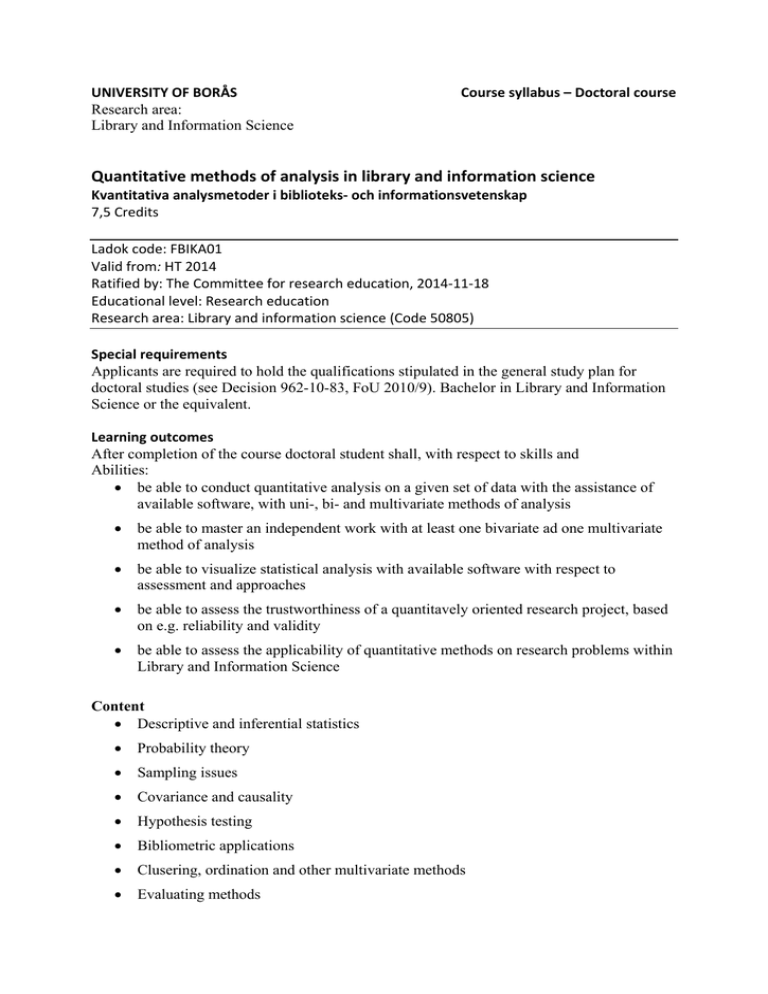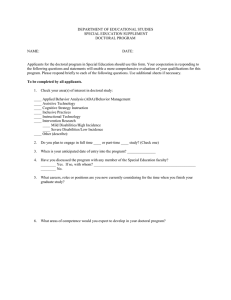Quantitative methods of analysis in library and information science
advertisement

UNIVERSITY OF BORÅS Research area: Library and Information Science Course syllabus – Doctoral course Quantitative methods of analysis in library and information science Kvantitativa analysmetoder i biblioteks- och informationsvetenskap 7,5 Credits Ladok code: FBIKA01 Valid from: HT 2014 Ratified by: The Committee for research education, 2014-11-18 Educational level: Research education Research area: Library and information science (Code 50805) Special requirements Applicants are required to hold the qualifications stipulated in the general study plan for doctoral studies (see Decision 962-10-83, FoU 2010/9). Bachelor in Library and Information Science or the equivalent. Learning outcomes After completion of the course doctoral student shall, with respect to skills and Abilities: • be able to conduct quantitative analysis on a given set of data with the assistance of available software, with uni-, bi- and multivariate methods of analysis • be able to master an independent work with at least one bivariate ad one multivariate method of analysis • be able to visualize statistical analysis with available software with respect to assessment and approaches • be able to assess the trustworthiness of a quantitavely oriented research project, based on e.g. reliability and validity • be able to assess the applicability of quantitative methods on research problems within Library and Information Science Content • Descriptive and inferential statistics • Probability theory • Sampling issues • Covariance and causality • Hypothesis testing • Bibliometric applications • Clusering, ordination and other multivariate methods • Evaluating methods • Limitations and applicabilities of quantitative approaches Teaching methods Tuition is conducted in the form of lectures, exercises, seminars and labs. Tuition is given in English. Grades and types of examination The course is examined through written assignments and a seminar. Doctoral student is graded pass (P) or fail (F). Grades are expressed as either Pass or Fail. Reading list The first two books are similar, and the doctoral student choose what he/she wants to read. Agresti, A. & Finlay, B. (2014). Statistical methods for the social sciences. (4.ed.) Harlow, Essex: Pearson. OR Djurfeldt, G., Barmark, M., Gustafsson, J., Raduta, S., Sjödin, D., Stjärnhagen, O., SvenssonHenning, M. & Teorell, J. (2010). Statistisk verktygslåda 1 & 2 – paket. Lund: Studentlitteratur. Nicolaisen, J. (2007). Citation analysis. Annual review of information science and technology, 41(1), 609-641. Wildemuth, B. M. (2009). Applications of Social Research Methods to Questions in Information and Library Science. Westport, CT.: Libraries Unlimited. Chapters 5, 11-13, 18, 29, 33-37. Additional material in the form of seminar readings and instruction material for workshops is needed, as well as additional literature for assignment tasks may be. Course evaluation Doctoral student shall be involved in further development of the course and are therefore given the possibility to assess the course in a systematical way by written or oral means. How this assessment falls out and how it affects further development will be reported back to doctoral students. For course evaluation, the standard University College of Borås rules as of 7 June 2005 apply, dnr 56-02- 10. Other Doctoral student admittance is prioritized before any other student can be admitted. The doctoral student should be given the rights to install necessary software on hardware provided by the university, or the university should, in the shortest time possible, install such software for the doctoral students to use.

